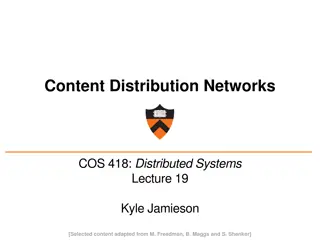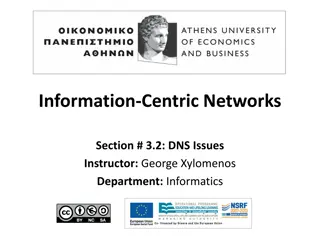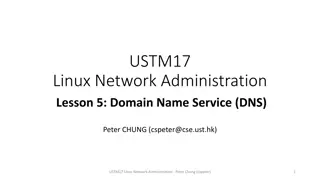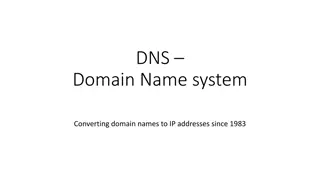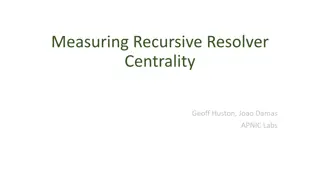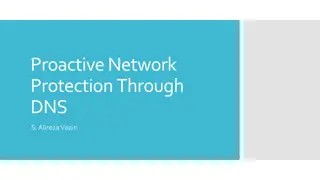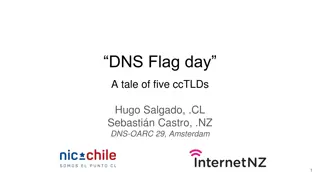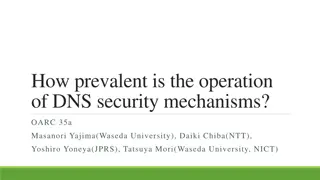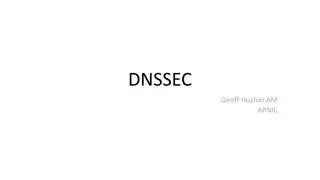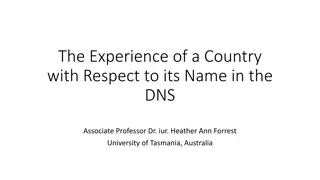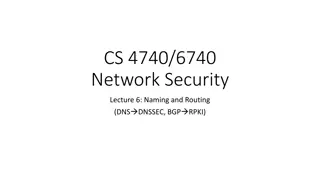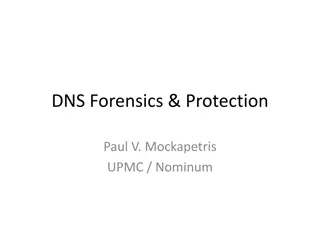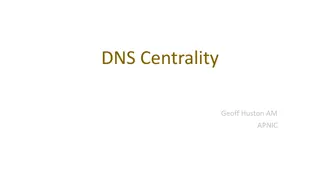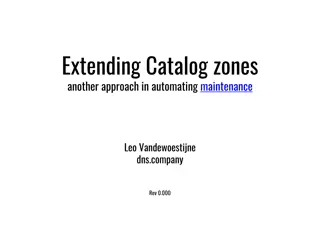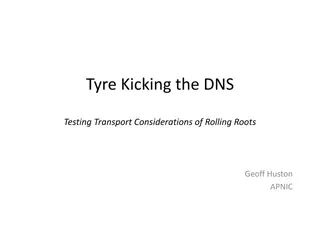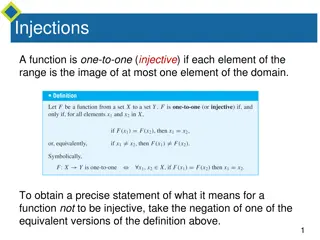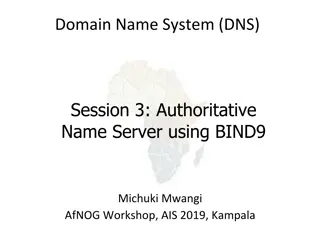Understanding the Domain Name System (DNS) Structure
The Domain Name System (DNS) is a distributed data collection utilizing a delegation hierarchy to reflect the hierarchical structure of domain names. This system resolves DNS names by discovering information through iterative searches, starting from the root zone. The process involves querying servers for different zones based on the given domain name to ultimately retrieve resource records. Learn more about the DNS structure and resolving process in this comprehensive guide.
Download Presentation

Please find below an Image/Link to download the presentation.
The content on the website is provided AS IS for your information and personal use only. It may not be sold, licensed, or shared on other websites without obtaining consent from the author. Download presentation by click this link. If you encounter any issues during the download, it is possible that the publisher has removed the file from their server.
E N D
Presentation Transcript
The Root of the DNS Geoff Huston APNIC March 2017
The Structure of the Domain Name Space . ( root ) com. www.example.com. example.com. Domain Names are a sequence of labels delimited by the period character that reflect a hierarchical name structure www.example.com.
The Structure of the Domain Name System The Domain Name System (DNS) is a distributed data collection using a delegation hierarchy that reflects the internal hierarchical structure of domain names. At each level in the name hierarchy each label represents a potential point of administrative delegation . ( root ) zone Delegation of the label com com. zone Delegation of the label example www.example.com. example.com. zone terminal label www Each zone contains a list of defined labels www.example.com. Labels can either reflect a delegation to a subordinate zone or they can be a terminal label that contains attribute information associated with that label
Resolving a DNS Name Your resolver needs need to ask a DNS server for the zone that contains the terminal label for the associated information (resource record) associated with the DNS name But Where exactly is the zone cut? Who are the servers? So resolvers discover this information by performing a top-down iterative search
Resolving a DNS Name Qname: www.example.com.? . ( root ) zone server Response: servers for the com. zone
Resolving a DNS Name Qname: www.example.com.? . ( root ) zone server Response: servers for the com. zone Qname: www.example.com.? com. zone server Response: servers for the example.com. zone
Resolving a DNS Name Qname: www.example.com.? . ( root ) zone server Response: servers for the com. zone Qname: www.example.com.? com. zone server Response: servers for the example.com. zone example.com. zone server terminal label Qname: www.example.com.? Response: Resource records for terminal label www.example.com.
How do we use the Root Service? In the next few slides we ll describe DNS behaviours and their use of the Root Service. The DNS is full of variations in behaviour, and we can t describe them all, so we ll stick to what we observe as common behaviour here
Every DNS Resolver starts up by asking a root server a priming query Resolvers typically have a hints file to bootstrap into the DNS, but they use this to refresh the list of root name servers by asking one of the roots for the list of name servers for the root zone (the priming query) Root Server Role: Answer priming queries about the root zone
Every Name Resolution query starts by asking a root server
Every Name Resolution query starts by asking a root server In theory! In practice, resolvers cache the responses they receive, and then use the cache for subsequent queries This holds for the root zone as much as all other zones in the DNS, so in practice most queries for delegated domain names do not start with queries to the root zone
Every DNS Resolver asks a root server about unknown names DNS resolvers do not conventionally cache the entire root zone, but populate a local cache incrementally based on the names they are tasked with resolving When a query cannot be answered from the local cache, the resolver will query a root server Root Server Role: Answer cache miss queries from resolvers
Root servers are promiscuous responders Root servers do not know the reason for receiving a query, and have no policy about whether or not they should respond and with what information Root servers respond using a common current copy of the root zone to form their response Root Server Role: Answer all queries presented to root servers in a uniform and consistent manner based only on information in the root zone
Root Service MUST be available Not every root server needs to be reachable from every resolver that asks DNS queries, but at least one server must be available to respond to queries If a resolver cannot reach ANY root servers then when its local cache expires it will be unable to answer queries. It will go dark Root Server Role: The aggregate system of root servers must be available to respond to queries at all times
Root Service needs to be fast enough An available Root Server should respond to queries in a timely manner The faster the root server can respond the faster the overall DNS resolution time when the local resolver(s) have cache misses on the query, but there are no pre-defined target response times Root Server Role: The aggregate system of root servers must respond to queries within a reasonable time
Anycast Root Servers 12 of the 13 root server letters operate some form of anycast server constellation. All the servers in a constellation respond to the same public IP addresses. The routing system will direct resolvers to pass their query to a particular root letter to the closest member of the letter s anycast constellation. Anycast provides: faster responses to queries to the root for many DNS resolvers Greater resilience to hostile traffic by load sharing widely distributed attacks across the entire anycast constellation, and absorbing a single point attack on a single server instance
Using the Root Service The main role of the root server system is to answer queries that are not cached in local name caches There are many more well-formed top level labels that are not delegated labels in the root zone than those that are (1,530) That means that the vast majority of the queries that are passed to the root zone servers generate a no- such-name (NXDOMAIN) response from the root system
Which Root? There is no generic any root server address for a resolver to use. Resolvers need to send their queries to a specific letter. Which letter they pick is up to the resolver. Some do round robin, some latch on to the one they think is faster. There are no particular rules that resolvers use here. It s not clear that resolvers use any particular heuristic to guide their choice of root server letter, nor is it clear that it matters in any case. If there is no response, then the resolvers will switch to another root letter and repeat the query.
Futures for the way we use the Root Service As the traffic levels to the root servers increases both as steady state query levels and instances of attacks, we keep on building bigger servers and add more instances to the existing anycast clouds Can we improve the behaviour of the total system to improve its overall scaling properties without singling out the root server system?
DNSSEC changes Everything Before DNSSEC we relied on the assumption that if we asked an IP address of a root server then the response was genuine With DNSSEC we can ask anyone, and then use validation to assure ourselves that the answer is genuine How can we use this?
DNSSEC-Enabled Directions for the Root Service DNSSEC opens some fascinating possibilities, allowing us to explore other options in how the root zone is distributed towards DNS resolvers in addition to the convention collection of Root Server Letter anycast constellations The underlying ability provided by DNSSEC is that no matter how you obtain a response from the root zone, you can validate its authenticity with DNSSEC This allows us to enlist DNSSEC-aware DNS resolvers to provide authoritative DNS responses from their local cache that would ve otherwise required a query to a root server. This can be used to provide a significant augmentation to the capability of the root system without actually changing the scale or capability of the dedicated root zone servers themselves
Local Root Secondaries - RFC7706 Enlist DNS resolvers to offer a root zone secondary service If resolvers use this approach then they only need to query a root server infrequently and perform a zone transfer of the current state of the root zone (IXFR from a root server), and use this validated copy of the root zone to directly answer all queries that refer to the root zone
Aggressive NSEC caching Most of the queries seen at the root are for non-existent domains Resolvers cache the nonexistence of a given name But a DNSSEC-signed NXDOMAIN response from the root zone actually describes a range of labels that do not exist, and it s the range that is signed, not the actual query name If resolvers cached this range and the signed response, then they could use the same signed response to locally answer a query for any name that falls within the same label range This has a similar effect to RFC7706, but without any configuration overhead, nor is there any requirement for supporting root zone transfers. This approach increases the effectiveness of the local cache by allowing the local resolver to learn entire ranges of non-existent names in the root
Research and Analysis Can we peer inside the interactions between DNS resolvers and root servers to look at how the use the root system? Can we see to what extent resolvers spread their queries across the entire collection of root servers and to what extent they express a preference to use what they see as the fastest such server? What is the interaction between V4 and V6 transports for the root servers and the anycast distributions? What local caching parameters are used by DNS resolvers for root zone data? To what extent do DNS resolvers ask for DNSSEC signatures for root zone data?


